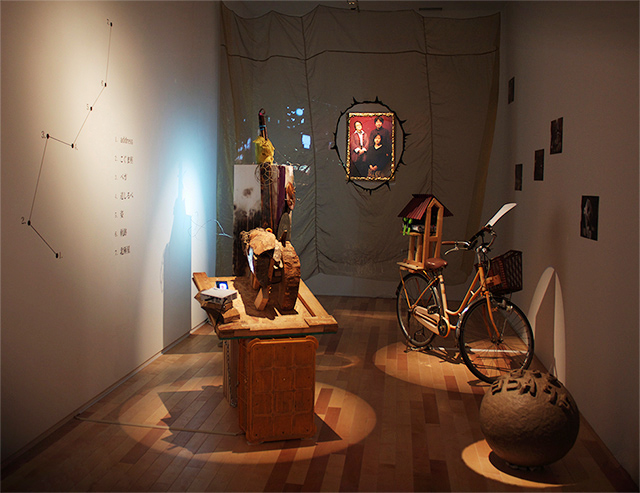日本語 | English
Re-sewing Constellation: Thought Processes behind Chiaki Haibara’s Work
Text by Ryo Katsumata (Curator of Re-sewing Constellation)
Just as the stars cannot be seen in the middle of a sunny day, let us assume that hidden somewhere in the air saturated with strong light, there is a weaker light or multiple sources of weaker light. In contrast to the sharp outlines of objects lit under the strong light, the weaker light escapes our vision as if it does not exist at all. But if the supply of the strong light were to be interrupted momentarily for some reason, its level of visibility will be exchanged with that of the hidden light, in correlation to the degree of interruption. What was once hidden will be revealed and what was visible will become hidden. This circuit of exchange repeats itself, intricately changing its expressions each time.
When thinking about Chiaki Haibara’s work, it seems as though some of her pieces speak to these circuitries. Her work does not offer a complete form of representation. Rather, they are tied to images of something that is incomplete, that is to say, is in the process of construction or becoming known. For this reason, they almost necessarily appear durational and kinetic. At times the body becomes the medium of such an image and it engages or is engaged with a particular object or another body.
Playground (2015) [fig. 1] is an example of her work that incorporates the body. This piece was shown in the exhibition Suddenly, the View Spreads out before Us (2015), a joint project between Musashino Art University and the adjacent Korea University. A video of this piece documents a series of actions in which performers play volleyball across a wall that separates the two schools. They use the wall as a net, but the wall functions to repel the gaze and the players are not permitted to observe the opponent’s side. It is difficult to visually follow how the ball will be received (or not received, as the case may be) and to predict how it will be returned. A player may well be caught off guard by a ball that suddenly appears in a completely unexpected way.
What exists there is a place of negotiation that is by no means effective, and anxious bodies that must engage in such a process. To put it conversely, if what can be seen and what cannot be seen (what does not need to be seen) are predetermined and fixed, we may live free of uncertainty and anxiety. But what Playground portrays is a process in which the players attempt to establish a rally, supplementing the exchange of the ball with the exchange of voices (for example, in one instance a participant reports, “we’ve added a player on our side”) precisely because the uncertainty cannot be ignored. This is also an effort to develop a system that can be shared between the teams.
A system that is formed in this way can be seen as a diagram of a relationship. But if we come to regard the diagram as a fait accompli (something that is predetermined), in that moment we internalize the very attitude that we were initially opposed to. In other words, even when such a diagram is established, uncertainties remain (the diagram is affected by complex changes in the relationship), therefore to accept the diagram as being fixed, i.e., to look past the variables as that which do not need to be seen, is to face away from the unknown. This attitude seems to contradict the initial intent of the actions: to confront the unknown. In the piece Imaging How to Move the Polaris—Several Tasks—, Haibara devised a procedure to break and push open a state of deadlock so it can be restructured as a new diagram. It is an act of somehow moving a thing that is predetermined and immobile. Historically, Polaris has been viewed as a star that is always anchored in the same position in the sky, and voyagers utilized it as a navigation guide to set the course of travel. But in reality, Polaris moves little by little. This is one of the phenomena Haibara draws upon in response to the task of “moving Polaris” as she successively modifies the motif of Polaris using imaginative elements such as myths and associations. Employing images and objects as the medium, the connections made legible in this process were plurally placed, and responsive connotations were activated in the spaces between the objects. In other words, she activates the magnetic field where meaning is formed, the comparative and referential diagram of various images. In principle, this diagram leads to a restructuring i.e., the act of re-sewing. This is analogous to a condition in which what lay in plain sight becomes hidden, and what was hidden comes into view. Within the dimension of meaning-production, Polaris has in fact “moved. ”
A moving Polaris may lead a voyager astray. This relationship between the star and the traveler somehow brings to mind the formation of the volleyball game. The qualities of this relationship are also related to the stance that Haibara takes in the exhibition Re-sewing Constellation, for which I am writing this text. Each time the distance changes between the videographer (camera) and the dancer, parts of the body repeatedly come into focus, then out of focus, and back into focus. Each equipped with its own distinctive attributes, the images are thrown into a medium that is potentially malleable, and are refracted, transmitted, reflected, oscillated or diffused. The performer’s dance is based on a state of religious trance. Given this fact, I wonder if it is reasonable to anticipate that the work, in a new form, is engaged in the redefinition or the demarcation and dissolution of the outline that is the body of one’s self.
Translated by Kione Kochi

”lighthouse vol.12 勝俣涼企画
灰原千晶『縫いなおされる星座』”
発行日:2017年12月7日
発行:switch point
写真:星野健太(p2,6-7,8,9,10)
デザイン:本郷かおる(switch point)
執筆者:勝俣涼
lighthouse vol.12 Curator=Ryo Katsumata, Chiaki Haibara solo exhibition “Re-sewing Constellation”
The date of issue :7th December, 2017
Publisher:switch point
Photo:Kenta Hoshino(p2,6-7,8,9,10)
Book design :Kaoru Hongo(switch point)
writer:Ryo Katsumata
*This brochure was published as a catalog of the exhibition.

